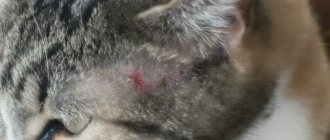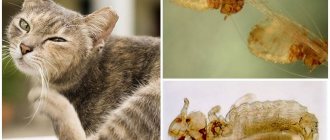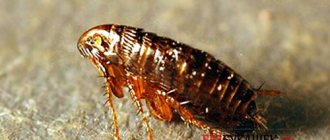Main causes of itching
All causes of itching in cats are divided into several groups.
Ectoparasites
This group includes subcutaneous and cutaneous mites, as well as other blood-sucking parasites. When they appear, dandruff and other flaking appear, hair falls out, and the cat itches until it bleeds.
Severe itching is characteristic of the following diseases:
Allergies
With a food allergy, the cat actively scratches its face and ears, licks and bites its paws. This happens when there is a sudden change in food or the introduction of new foods into the diet. Most often, allergies are caused by insect bites: mosquitoes, wasps, bees, ants.
Interesting! Food allergies in cats often occur when there is a sudden change in food.
Some cat breeds are prone to seasonal allergies. Itching is caused by pollen, house dust, and certain plants. Contact with chemicals and household products also leads to itching and irritation.
Important! Atopic dermatitis cannot be cured. The doctor only prescribes maintenance medications. They reduce symptoms and are given to the animal for the rest of its life.
Contact allergies are a rare type. It occurs when an allergen comes into contact with an animal's skin. As a rule, this is the area of the abdomen and chest. If this type of reaction is suspected, allergy tests are performed.
Skin infections
If your cat is itching but there are no fleas, skin infections may be the cause. They most often join the primary problem. As a result of the activity of bacteria, eczema and weeping wounds develop on the pet's skin. The cat licks them, which causes open wounds.
The development of a fungal disease is indicated by bald areas of the body, peeling and changes in pigmentation. Dermatophytosis manifests itself in individual foci or their connection throughout the body.
Dermatophytosis is characterized by inflammation of the skin in places where it is damaged. These can be insect bites, allergic and neurological wounds. There is redness, swelling or swelling of a certain area on the cat's skin. If an animal scratches its skin vigorously, the temperature of that part of the body rises.
Dry skin
Due to a lack of vitamins A and E in the body, as well as when choosing poor-quality hygiene products, the skin dries out. This process is accompanied by severe itching. First, the cat itches on the sides and back. Then dandruff appears, the skin dries out and cracks in places. The coat does not fall out, but noticeably becomes dull and loses its healthy appearance.
Autoimmune pathologies
Autoimmune pathologies are quite difficult to diagnose and treat. They are characterized by a violation of the body's immune system. As a result, protective cells perceive their own cells and tissues as foreign and attack them.
Important! Discoid lupus erythematosus occurs most often in dogs and is extremely rare in cats.
Such pathological processes are characteristic of diseases:
- Discoid lupus erythematosus. It is characterized by the sudden appearance of wounds and other injuries on the body. In this case, antimicrobial drugs do not give results. Immunosuppressants and glucocorticoids are effective in suppressing this process.
- Jacobs ulcer. This is truly a cat disease. It is characterized by the appearance of a sore on the upper lip of the animal. At first it is a small bubble. Then it turns into an ulcer. If left untreated, teeth and gums become exposed. Antibiotics and wound-healing drugs do not give results.
- Pemphigus foliaceus. The cat itches to the point of sores in the face area. Infections and bacteria often penetrate into scratching areas. This leads to tissue inflammation and the appearance of crusts.
Psychogenic factors
Cats do not tolerate stressful situations well. And at the slightest nervous tension there is a risk of psychogenic itching. The animal begins to chew its tail or itch. In this way the pet calms itself. Soon a dependence on this process arises.
Interesting! Diagnosing psychogenic itch is a complex process. It is determined by excluding other possible causes.
Other reasons
When there are hormonal imbalances, the cat constantly itches and licks. These symptoms are characteristic of the following pathologies.
Cats often itch due to ear infections. Itchy places are the ears, neck and head. With otitis media, discharge containing pus or wax appears from the ears. Marginal seborrhea affects only the tips of the ears. Outwardly, they lose their previous shape, look ugly and unkempt. A bacterial infection is often associated.
Interesting! The most common sign of ear disease is a cat constantly shaking its head.
In the tail area, cats will often wash and lick themselves when the paraanal glands are blocked. The animal can sit and move its butt along the floor. This problem occurs due to poor nutrition. Similar symptoms are characteristic of helminth infection. Determining the exact diagnosis is carried out by exclusion.
Itching caused by helminths
Helminths not only have a pathological effect on the cat’s digestion. Worms cause loss of essential nutrients by absorbing micronutrients from the intestines. As a result of lack of nutrition, the pet's skin becomes dry, dandruff appears, and the cat licks itself much more often and more intensely, trying to get rid of the itching.
Intoxication of the animal's body with waste products and toxins produced by worms provokes an allergic reaction, skin rashes, and itching. Even a tiny kitten can suffer from helminthiasis after acquiring parasites from an adult cat. Therefore, if the kitten is itching, it is necessary to check its feces for the presence of worm eggs. The area around the anus may also itch when helminths crawl out to lay eggs. The cat then behaves characteristically - it “rides” on the carpets with its butt, relieving the itching.
There are 3 types of helminths parasitizing the body of cats:
- roundworms;
- tapeworms;
- flukes.
Some species are transmitted through flea bites to humans. The presence of worms in kittens leads to delayed growth and development, and in pregnant cats, worm infestation can cause miscarriage. In the presence of individual individuals in the body, the disease can be asymptomatic. Fleas also transmit helminthiasis to other pets, so all inhabitants of the house need to be treated.
Medicines for helminths
If the itching is caused by worms, then it is necessary to deworm the animal. For this purpose, as prescribed by the veterinarian, the animal is given Prasitel, Pyrantel, Trontsil K, Kanikvantel, Profender, Polyvercan (sugar cubes), Panacur, Febtal, Dirofen, Milbemax, Drontal. But first you should undergo an examination and determine the type of parasite, since broad-spectrum drugs are much more toxic than those that act selectively.
What should the owner do if the cat is itching and licking?
Owners are usually alarmed if a domestic cat frequently licks and scratches itself. And such problems must be resolved immediately. Otherwise, the animal’s behavior will lead to the appearance of deep wounds and scratching. And they are dangerous due to the penetration of pathogenic fungi and bacteria.
There are many reasons for such symptoms. This means that looking for them on your own is pointless and even dangerous. In order not to waste time, the best solution is to contact a veterinarian.
Important! The maximum allowable help from the owners is to treat the pet for worms and fleas. If the animal continues to itch all the time, you need to contact a veterinarian.
Treatment
The course of treatment is based on a special diet and medications. Some drugs can cause allergies, so they must be given under the supervision of a veterinarian.
The set of drugs depends on the type of disease:
- In case of fungal infection of the skin, the veterinarian takes tests, based on the results of which he chooses a treatment regimen. Therapy is based on taking drugs from the griseofulvin group. Itching is relieved by using a topical antifungal agent. Vaccination is also provided.
- When the sources of scabies are flea bites, drops and sprays are prescribed. When bathing, use a special shampoo, and then put on a flea collar.
- Deworming helps rid your cat of worms. The veterinarian prescribes one of the drugs depending on the type of parasite identified during the examination.
- Ticks are removed with acaricidal agents (sprays, shampoos, drops). These drugs relieve itching.
- Allergic reactions are treated with antihistamines to reduce itching. Remove the allergen from the diet and carefully select a hair care product.
- For an infectious disease (otitis, pyoderma, dermatosis), antibiotics, anti-inflammatory drugs, vitamins B and A, and immunomodulators are prescribed.
- Stronghold is prescribed for allergic dermatitis, flea bites, and ear scabies. Available in the form of drops and applied to the cat's neck.
To speed up wound healing, use externally:
- iodine;
- honey;
- silver water;
- coconut and lavender oil;
- calendula tincture;
- vitamin E.
Infectious diseases of cats are secondary in nature and are not transmitted to humans. On the contrary, people become a source of infection for cats.
When using the ointment, put a collar or T-shirt on the cat so that it cannot reach the affected areas of the skin with its paws.
Special diet
During treatment, dietary products are selected for the cat, the consumption of which reduces the intensity of itching and the likelihood of relapses. Your cat's daily diet should be balanced. It is not recommended to give smoked and sweet foods.
Adviсe:
- 1. If the cat was eating food before the allergy appeared, then purchase a hypoallergenic variety.
- 2. When a cat is fed regular food, pork, potatoes and cereals are removed from the diet. They give fish, butter and vegetables.
- 3. Adding fish oil to food (tuna, salmon, sardines, anchovy) helps reduce itching.
Timely adjustment of the diet and daily monitoring of the animal’s condition are required.
Diagnosis of itching in the clinic
There is a certain diagnostic algorithm if a cat’s skin begins to peel, hair falls out, and other dermatological symptoms are observed - it itches, licks:
- Anamnesis collection. The owner provides information about the cat’s breed and age, nutritional habits, and preventive treatments.
- Itching analysis. The doctor determines whether the skin is itchy all over the body or in certain places. Equally important is the frequency and frequency of symptoms.
- Scrapings from places where the kitten itches most often. It is carried out to determine bacterial and fungal infections.
- Analysis for the presence of skin and subcutaneous parasites.
- Examination of the ears for otitis media, ear mites or seborrhea.
- Elimination diet to identify allergens.
- Exclusion of atopic and other types of allergies in cats.
After the diagnosis is made, treatment for the cause itself is prescribed. Elimination of itching is a secondary focus, so the cat may continue to itch during treatment.
Treatment at home
Treatment at home includes taking medications and following a special diet.
Medicines for helminths
The drug is selected depending on the type of disease:
- Scabies from flea bites is treated with special drops and sprays. Anti-flea shampoos are used during bathing. Then a flea collar is put on the animal.
- Itching caused by fungal infections is eliminated with drugs from the griseofulvin group. The antifungal agent is applied externally. You can also get vaccinated.
- To get rid of ticks, acaricidal substances are used in the form of drops, sprays and shampoos. Drops against ear mites are instilled into the ears.
- To eliminate allergic reactions, it is necessary to remove the allergen from the diet and care products. For further treatment, antihistamines are used.
- Deworming medications help get rid of worms. During the examination, the doctor identifies what type of worms have affected the intestines and prescribes appropriate treatment.
- Dermatosis, otitis media and other infectious diseases are treated with antibiotics and anti-inflammatory drugs. To strengthen the immune system, the animal is prescribed vitamins A and B and immunostimulating drugs.
- Allergic dermatitis and ear scabies are treated with Stronghold. This drug is released in the form of drops that are applied to the animal’s neck. It also helps with flea bites.
Therapy
You cannot treat a cat that is constantly licking and itching on your own. The diagnostics carried out reveal the true reason for this behavior. And based on it, the veterinarian prescribes a certain set of drugs. Therapy is divided into two groups:
- Etiotropic. The action is aimed at eliminating the cause that causes itching. The most effective option.
- Symptomatic. Treatment is aimed at controlling symptoms, particularly itching. It is temporary. Ineffective.
Important! The owner can help the animal if he follows all the veterinarian’s instructions. Stopping or adding medications on your own can cause serious harm to your cat.
Prevention
To prevent your cat from itching, you should regularly treat it with anti-flea medications or wear an anti-parasitic collar. This must be done regardless of whether the animal goes outside or not. Once every six months it is necessary to visit a veterinarian to examine the cat and, if necessary, clean its paraanal glands. Once every 3-6 months, in the absence of contraindications, it is advisable to give the animal a course of vitamins with biotin for healthy skin and coat. If itching occurs, you should seek help from specialists, avoiding self-medication.
Our clinic employs veterinary doctors - dermatologists Ekaterina Sergeevna Novik and Oksana Anatolyevna Maykova. You can find out their work schedule and ask all your questions by calling our phones.
Other causes of mange in cats
Stress
Severe emotional shock leads to skin reactions, including itching. Stress can cause dermatitis and eczema.
Lice (lice eaters)
Parasites that feed on exfoliated pieces of skin and hair.
The main symptoms of lice:
- Severe scabies.
- Hair loss.
- The appearance of cracks and crusts on the skin.
The following treatments are used: insecticidal drops, spray and shampoos.
Acne
This is a skin disease that occurs when the sebaceous glands become inflamed.
Symptoms:
- Rashes with white or black tips.
- Redness of the skin.
- Swelling.
- Itching and pain.
- Purulent blood crusts.
- The cat is actively itching, causing infection in the wound.
Treatment:
- Bathing your pet with tar soap or shampoo.
- Applying an antiseptic solution (chlorhexidine, miramistin, hydrogen peroxide).
What will the vet do?
If your cat is itching, it is best to show the animal to a veterinarian. Self-medication or ignoring alarming symptoms can cause the pathological condition to become chronic or cause severe consequences.
In a veterinary clinic, treatment of itching is carried out by identifying and eliminating the causes of its occurrence. To do this, tests are taken from the animal to determine the main etiological factor in the development of the disease. Next, the necessary treatment is prescribed, this can be either drug therapy or the selection of the necessary diet.
Skin diseases
Skin diseases in cats can also cause itching and discomfort.
One of the reasons may well be pyodermatitis - a secondary bacterial infection localized both in the deep layers and on the surface of the skin. Also, a disease such as cheyletiellosis, which is caused by mites of the genus Cheyletiella, can lead to itchy skin in cats. These mites look like fast-moving miniature white specks. Most often they can be found along the back. This infectious disease is popularly called “wandering” or “pityriasis” scabies.
This is also interesting: Where do fleas come from on domestic cats? Answered by a qualified veterinarian
But pruritic scabies (notoedrosis) is caused by mites that are similar to Sarcoptes. This infectious disease is highly contagious and is transmitted from a cat through direct contact.
Less common in cats is demodicosis, an infectious disease caused by demodectic mites. In addition to scabies, the cat has dermatitis, as well as baldness (as in the picture on the left).











